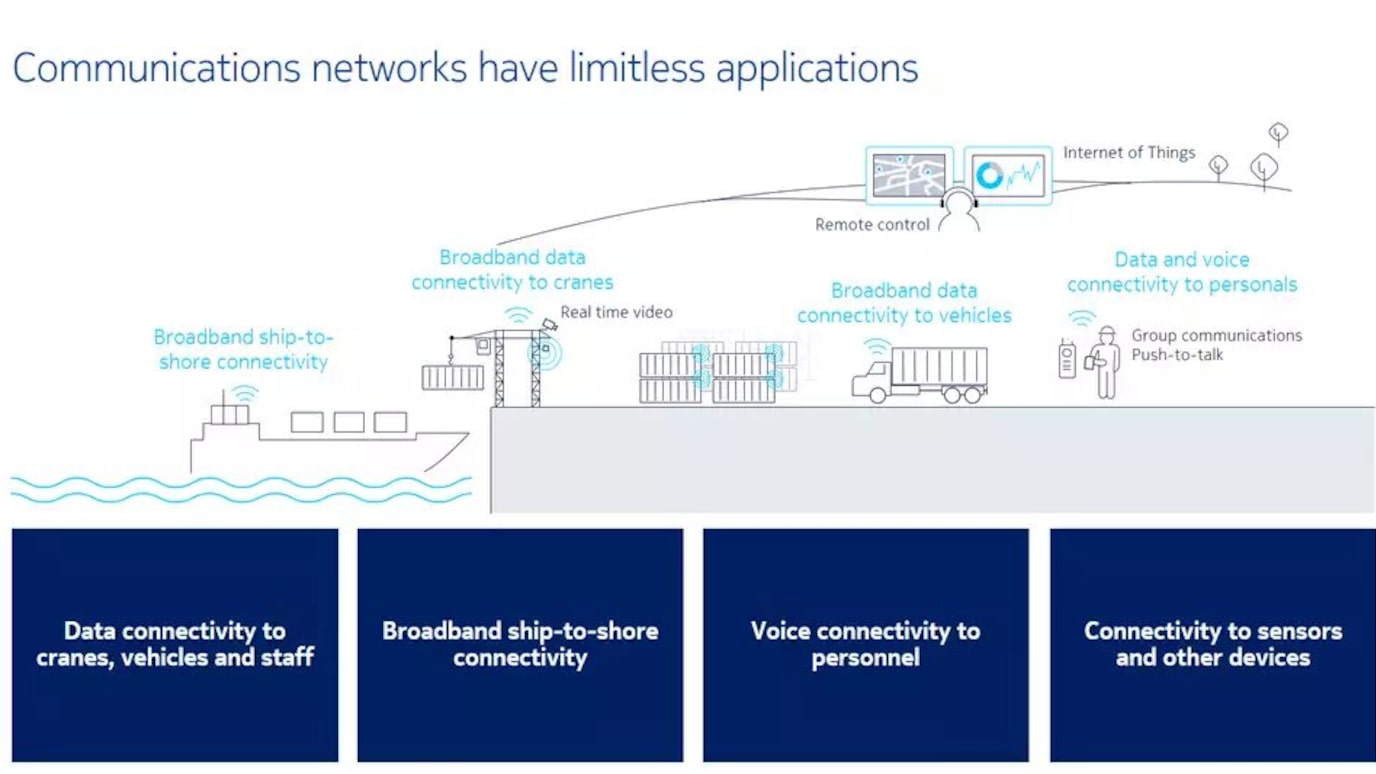Private LTE-based networks for terminal operators

Meet the critical automation and mobility needs of smart ports cost-effectively
The maritime industry has embraced the concept of smart ports and Port 4.0, but many terminal operators still lack a reliable and dedicated wireless connectivity infrastructure that can ensure operational efficiency for cargo handling, employee safety, and data security.
As competition grows tougher, ports need to get smarter, not just bigger. That means leveraging the latest ICT innovations. Nokia offers scalable, modular solutions to help you make the most of network capabilities.
Challenge: Complex turnaround, large workforce, and many moving assets
As container traffic by sea keeps growing globally — and physical port expansion conflicts with the growth of cities — container terminal operators must handle larger vessels, staff, and machines in relatively compact areas. But idle containers, information silos, and limited automation make it hard for terminals to run 24/7, even though downtime is not an option.
Solution: Wireless but reliable, LTE is the cornerstone of smart ports
Private LTE-based networks are the only technologies that really meet a smart port’s needs. Whether you choose licensed bands, unlicensed MulteFire, or shared spectrum CBRS, you can get the coverage, capacity, control features, reliability, and availability required for smart port success.
Nokia provides the access points (small cells and base stations) and the evolved packet core, which can be centralized or distributed.
Reliable and flexible
LTE-based networks provide the reliability of wired Ethernet with the flexibility of wireless
App prioritization
The LTE Quality of Service model lets you prioritize applications at multiple layers
Available and secure
Get crucial availability and security for business-critical communications
Meet the critical automation
These scalable and modular networks make it very easy to retrofit any existing terminal.
- Terminal operators can deploy as many access points as they need, at the speed they prefer. For instance, you can add small cells when the area to cover or the number of devices grows.
- Once the few basic components for a private network are in place, others can be plugged in and out as needed. For example, applications on the edge-computing platform can be added, and the platform itself can run on Commercial Off the Shelf (COTS) components, combined with different access networks.
- Because the network is wireless, no digging for cables is required to connect equipment located far from traditional Ethernet wire spots.


Retrofit your container terminal with today’s most reliable mobile broadband
Nokia’s private LTE networks give terminal operators a cost-effective way to outperform the competition. With new smart port capabilities, you can boost efficiency, support new business models, and improve worker safety.
Solutions for terminal operators
Solutions
- LTE in unlicensed spectrum
MulteFire uses unlicensed spectrum to combine the high performance of LTE with the simple deployment of Wi-Fi.This Nokia solution can be deployed by operators, cable companies, ISPs, building owners, and enterprises. - LTE in shared spectrum
Easy to install wireless for Enterprises, Industries, and Public Spaces - Multi-access Edge Computing
MEC processes data close to where it is generated and consumed. As a result, networks can deliver the ultra-low latency required by business-critical applications and support interactive user experiences
- Compact LTE solutions
Nokia provides innovative, rapidly deployable, compact and ultra-compact LTE solutions. Different form factors are available for emergency and disaster recovery situations and to establish coverage in remote areas. - Worldwide IoT network grid as a service
The Nokia worldwide IoT network grid, or WING, is a managed service created with communication service providers (CSPs) and enterprise customers in mind. This service helps you enter the world IoT and enables further growth of existing IoT offerings.
- LTE in unlicensed spectrum
MulteFire uses unlicensed spectrum to combine the high performance of LTE with the simple deployment of Wi-Fi.This Nokia solution can be deployed by operators, cable companies, ISPs, building owners, and enterprises. - LTE in shared spectrum
Easy to install wireless for Enterprises, Industries, and Public Spaces - Multi-access Edge Computing
MEC processes data close to where it is generated and consumed. As a result, networks can deliver the ultra-low latency required by business-critical applications and support interactive user experiences
- Compact LTE solutions
Nokia provides innovative, rapidly deployable, compact and ultra-compact LTE solutions. Different form factors are available for emergency and disaster recovery situations and to establish coverage in remote areas. - Worldwide IoT network grid as a service
The Nokia worldwide IoT network grid, or WING, is a managed service created with communication service providers (CSPs) and enterprise customers in mind. This service helps you enter the world IoT and enables further growth of existing IoT offerings.